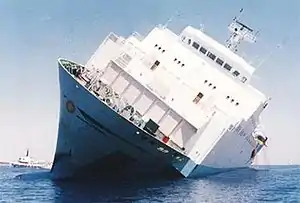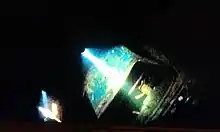MS Zenobia
MS Zenobia was a Swedish-built Challenger-class RO-RO ferry launched in 1979 that capsized and sank in the Mediterranean Sea, close to Larnaca, Cyprus, in June 1980 on her maiden voyage.[1][4] She now rests on her port side in approximately 42 meters (138 ft) of water and was named by The Times, and many others, as one of the top ten wreck diving sites in the world.[4][5][6]
 Zenobia listing in June 1980 | |
| History | |
|---|---|
| Name | Zenobia |
| Owner | Rederi AB Nordö[1] |
| Port of registry | |
| Builder | Kockums Varv AB, Sweden[1] |
| Launched | 11 August 1979 |
| Acquired | Late 1979[1] |
| Maiden voyage | May/June 1980 |
| Identification | IMO number: 7806087[3] |
| Fate | Sank close to Larnaca on 7 June 1980 |
| General characteristics | |
| Type | Challenger-class roll-on/roll-off ferry |
| Tonnage | 10,000 GRT[3] |
| Length | 172.2 m (565 ft 0 in) |
| Beam | 28 m (91 ft 10 in)[3] |
| Draught | 13.01 m (42 ft 8 in)[3] |
History
Zenobia was built at the Kockums Varv AB shipyard in Sweden and was delivered to her owners Rederi AB Nordö in late 1979.[1] She left Malmö, Sweden on her maiden voyage, bound for Tartous, Syria on 4 May 1980, loaded with 104 tractor-trailers with cargo destined for the Mediterranean and the Middle East.[2] She passed through the Strait of Gibraltar on 22 May 1980, stopping first at Heraklion, Crete and then to Piraeus, Athens, Greece.[2] On the way to Athens the captain noticed steering problems and Zenobia began listing to port.[2] Following checks, it was determined the list was caused by excess water that had been pumped into the ballast tanks; this water was pumped out and she then departed for her second to last stop at Larnaca, Cyprus before reaching Syria.[2]
She arrived at Larnaca on 2 June 1980,[1] where the ballast problem had reoccurred, engineers discovered that the computerized pumping system was pumping excess water into the side ballast tanks due to a software error, making the list progressively worse.[2] On 4 June, Zenobia was towed out of Larnaca harbor to prevent her becoming an obstruction should the worst happen[2] and was left at anchor roughly 1–1.5 miles (1.6–2.4 km) offshore.[2] On 5 June, with the ship listing at around 45° the captain dismissed the engineers and maintenance crew and requests from the captain to return her to Larnaca harbor were denied.[2]
At around 2:30am on 7 June 1980, Zenobia capsized and sank in Larnaca Bay at 34°53.5′N 33°39.1′E (1,500 m, 4,900 ft from the shore) to a depth of roughly 42 meters (138 ft),[2] taking her estimated £200 million worth of cargo with her.[2][7] There were no casualties in the disaster.
A Discovery Channel documentary investigated the theory whether Zenobia was sabotaged by Mossad and MI6.[8][9][10]
Of her two sister ships, Wawel is still operational as of January 2021; SeaFrance Cézanne was scrapped in October 2011.

Wreck diving
.jpg.webp)
The wreck is consistently ranked as one of the top 10 recreational dive sites worldwide.[11][12][13][14] As a dive site, Zenobia provides a wide range of challenges to scuba divers, from a fairly simple dive to 16 meters (52 ft) depth along the starboard side of the ship (suitable for newly qualified divers); moving up to a more advanced dive inside the upper car deck and accommodation block, right up to extremely adventurous dives within the lower car deck or the engine room (which are only suitable for very experienced divers).[15][16][17][18]
References
- "Forgotten Sister - The Zenobia Story". HHVFerry.com. Retrieved 3 July 2010.
- "Zenobia History". Kembali-Diving.com. Archived from the original on 4 November 2016. Retrieved 3 November 2016.
- "Diving the Zenobia shipwreck". ProScubaDiver.net. Archived from the original on 8 July 2010. Retrieved 3 July 2010.
- Ecott, Tim (3 March 2007). "World's best wreck diving". The Times. London. Retrieved 9 November 2009.
- BoatInternational.com: The World's Best Wreck Dives
- TheTravel.com: 20 Incredible Images Of Shipwrecks (You Can Actually Dive To)
- The Story About The Zenobia Shipwreck Cyprus
- "In Cyprus.com: Discovery Channel documentary investigates rumours about deliberate sinking of Zenobia (video)". Archived from the original on 14 July 2019. Retrieved 11 February 2020.
- Alpha Divers: Zenobia Wreck in Cyprus with Alpha Divers
- YouTube - Sean Flynn: Zenobia shipwreck, Mystery of the Spy Sabotage. Legends of the deep.
- Deeper Blue: Top 10 Wreck Dives In The World
- Leisure Pro: World’s Top 10 Wreck Dives
- Scuba Travel: Ten Best Dive Sites in Europe
- Dive In: Diving in Europe: 10 Best Dive Sites
- We Heart Diving: MS Zenobia Wreck
- TriBloo: MS Zenobia
- Dive Site Directory: Dive Site Zenobia
- Trip Advisor: Zenobia Wreck
External links
- Gallery Archived 7 July 2016 at the Wayback Machine
- Scuba diving